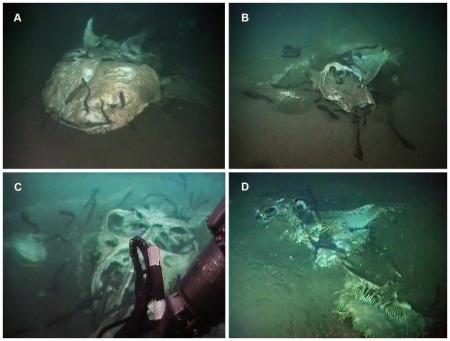What has been termed a ‘deep-sea graveyard’ discovered near the coast of Angola is helping scientists better understand the role decomposing creatures play in seafloor ecosystems.
Only a handful of large carcasses have ever been documented, according to a study published last week in the journal PLOS One. The discovery of several dead marine animals, including a whale shark and three rays, off the coast of Africa provides researchers with a rare opportunity to study large carcasses and the abundance of marine life they support.
According to the BBC, researchers from the oil and gas industry who were conducting surveys of the ocean floor uncovered the deep-sea graveyard between 2008 and 2010 on a 1-square-kilometre patch of the seafloor. Investigators used remotely operated vehicles to create video footage of the animal remains.
“There’s been lots of research on whale-falls, but we’ve never really found any of these other large marine animals on the sea bed,” Nick Higgs, a researcher with the University of Plymouth’s Marine Institute said in a statement, adding: “The reason we found them could be because of this industrial survey work — there are very few places surveyed as intensively as these areas.”
Higgs noted that through natural mortality — or even boating accidents and entanglement — animals living in surface waters end up on the seabed and become a meal for hungry ocean-floor scavengers. Often referred to as “whale fall” or “food fall,” these carcasses are found at depths of up to 2,000 metres, where they provide food to deep-sea life for decades.
Organisms that dine and dwell at whale falls include giant isopods, prawns, sea cucumbers, sleeper sharks and squat lobsters.
Meg Daly, an anemone specialist at Ohio State University, described whale falls as “some of the most stable deep sea communities” in the ocean. They are also home to previously unknown species, as was the case in 2007 when scientists discovered a new species of sea anemone living in the carcass of a whale off the coast of Monterey, California.
“To find four in such close proximity is unprecedented, suggesting that large food-falls are common in the region,” researchers of the new study wrote. “The cause of death of the animals identified here is unknown and most carcasses appear to have arrived at the seabed intact.”
While researchers didn’t observe any active feeding at the site of the newly discovered graveyard, they did note that several species of fish had begun “roosting” on or near the carcass. These were thought to be waiting for the arrival of smaller prey like crustaceans.
“We found three to four different types – but what really dominated were eel pouts,” Higgs said. “These normally sit around the carcass and wait for smaller scavengers — amphipods — to come along, and they will eat them.” Source: Philip Ross, IBT











